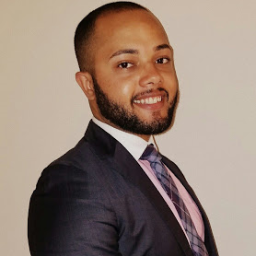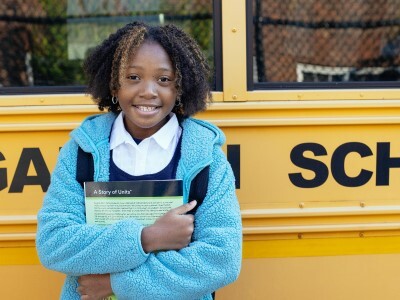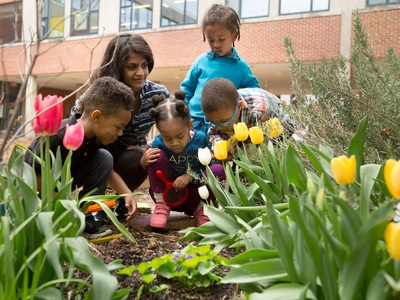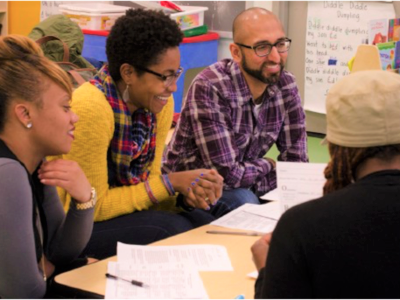In the Age of AI, Go Human!
Topics

When educators design and create new schools, and live next gen learning themselves, they take the lead in growing next gen learning across the nation. Other educators don’t simply follow and adopt; next gen learning depends on personal and community agency—the will to own the change, fueled by the desire to learn from and with others. Networks and policy play important roles in enabling grassroots approaches to change.
Are we building toward a future where technology amplifies our humanity, or one where it quietly replaces it?
Artificial Intelligence (AI) is no longer a distant experiment—it’s rewriting the rules of work, creativity, and connection in real time. As companies bet big on AI to “optimize” their systems, tens of thousands of workers are being displaced. We are all experiencing these ripple effects, whether directly or indirectly, as leaders make large bets on this technology to “better” systems and processes within their organizations. It comes at a cost for humanity, our connectedness and prospects for viable futures that were once the American dream. Consider the massive layoffs happening in this moment:
- Tens of thousands of layoffs are being blamed on AI. What are companies actually getting?
- YouTube offers voluntary buyouts as company reorganizes around AI
- The era of mega AI layoffs is here
In the education sector, AI brings promise to building more personalized learning environments where all kids can thrive, but creates a dangerous narrative for the continued siloization of humanity that was exacerbated during the pandemic. The question isn’t whether AI belongs in schools—it’s whether our systems and structures are evolving fast enough to preserve the social fabric that makes learning meaningful. Are we building toward a future where technology amplifies our humanity, or one where it quietly replaces it?
Our focus is centered around bringing community members together from all walks of life to think about the gnarly opportunities that exist within their school space.
I am sure that I am not the only one asking myself this and other questions at a moment in time where it may seem that everything is coming at us all at once due to the increasing access to information that artificial intelligence affords us. It is not all bad if we use AI as a tool in our wayfinding, but it could be a total disaster if this were the only way we chose to do school and work on a daily basis.
This is why I believe deeply in our education change management program at NGLC, Bravely. While we may use AI at different points in our change management process to augment an experience within our programming, it is not the central focus. Rather, our focus is centered around bringing community members together from all walks of life to think about the gnarly opportunities that exist within their school space. It certainly does make for an especially interesting coaching experience when you have a student who is experiencing a change, a teacher who is implementing the change, and a school/district leader who is in charge of helping to create the systems to enable that change, all being a part of one team figuring those things out. It takes building activities that meet everyone where they are and messaging the change and opportunity in ways that are accessible to all. It is through this approach that we position schools to create lasting change; the kind of change that lives not in one person but in a collective of humans invested in seeing their communities flourish. With Bravely, we ground the approach in the local context of the communities we serve, never as a cookie-cutter approach or a particular solution being sold to a community. It makes for a more equitable ecosystem of change agents paving the way forward for their communities to take on little bets that lead to lasting change. None of this happens as well in environments where AI, rather than humans, is the central driver.
Central to our coaching is human-centered design. This stems from research NGLC conducted across different school communities across the nation (Colorado, Georgia, California, Wisconsin, Ohio, Kentucky, North Carolina, and Pennsylvania) leading to the creation of our Transformation Design framework. The framework names the human aspects of the work in tandem with the systems/structural work when implementing change. We understand deeply that one cannot exist without the other. We argue that in the absence of one side of the coin, you end with change that only meets a community’s vision part of the way. In cases where this has happened, those furthest from opportunity, adults and students alike, carry the change in ways that further exacerbate inequities and lead to disillusioned humans who no longer believe in change.
We all have a role to play in building processes that require human connection that cannot simply be put into an AI algorithm.
Let’s be honest, AI is here to stay and keeping it out of schools and districts will also worsen equity issues that already exist in our public education system. We should, instead, be teaching our students and adults to be using it safely and appropriately so that they can still think critically. AI, for me, is a scaffold. I try to leverage the tool in ways that do not make me dependent on it and that keep my curiosity and critical thinking skills intact. Consider these metacognitive steps for using AI to augment an experience:
Step 1. Create a vision for an activity/process/engagement opportunity and a set of outcomes. You can have AI refine language wherever you feel you may need some support. As a lifelong multilingual learner, there are still some things in the English language that are challenging for me.
Step 2. Once you have clarity on the vision and purpose of the engagement, build a draft outline for a possible experience that you believe gets your learners to meet the outcomes. Much like in lesson planning, the activities must enable and position your learners to build mastery of a skill to meet the particular outcome it is being designed for.
Step 3. You can leverage AI here to give you feedback on the proposed outline. These are some suggestions, and I am certain there are other ways to engage with the tool:
- You can ask it to help you develop reflection questions to help spark thinking amongst your learners.
- You might co-design a protocol with AI that makes a direct connection to the community(ies) you are serving. This is an especially salient stage to ask it to help you build those human-centered activities that will meet your goals. It may seem ironic here to be asking AI to build a very human-centered experience, but the AI will give you something that you can strengthen and personalize more deeply for the community(ies) you are serving.
- You may ask AI to develop an intro/outro experience that ties everything together or closes any gaps within your design.
- If you do not use AI in step 1, you can just submit the draft into your AI of choice and ask it to determine what the vision and outcomes might be for the engagement design. This suggestion can help you determine whether these are the right activities to focus on or not.
Step 4. Revise, revise, revise! so that you do not lose your voice or uniqueness while using your AI tool.
We all have a role to play in building processes that require human connection that cannot simply be put into an AI algorithm. Might AI give you a great activity, process, or outcome idea that aligns with your vision? Yes. Might that replace the feeling of being in a room with other humans charging forward, being curious, making sense of innovative approaches together, and collaborating for a purpose? I’d say, not likely. To maintain a collectivist approach to our work, we lean on Blackfoot Nation’s belief that we all come into this world already self-actualized, but that we require an interdependence on community that expands on that individual self-actualization which leads to cultural perpetuity. We serve the community and the community serves us. Consider the following quotes from past Bravely participants:
“I have been reminded of the importance of bringing students' voices to the forefront. If we truly want to remove oppression, we need to center student voices rather than making decisions as adults who think we know what's best for them.”
“My perspective changed because I feel more confident in my role at the school, and Bravely meetings left me feeling charged up that we were making the moves we feel necessary instead of just sitting around complaining, waiting for someone else to do something about it.”
“I definitely want to consider how to deepen collective responsibility next year and how to make sure teacher and student voices are taken into account to do the work—I'm definitely taking away certain ideas districts shared today that help me to think about how we do this work with multiple stakeholders.”
“My Bravely experience helped me to create a shared purpose with my students more. I found that when students are given the chance to voice what they want/expect from a certain activity, they are more engaged and there are less disruptions.” (See this NGLC article for more on that point)
All of these perspectives are a reminder for me that this continues to be the right work. We must act now to maintain and preserve that which brings us closest together, through a collectivist approach. We can do this while carefully treading the aspects of AI that allow us to continue to be curious in nature, to be critical thinkers that make decisions based on data and facts, and to join in wonder with others to make change possible in our communities.
Photo at top courtesy of Montessori for All.




